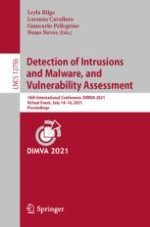2021 | OriginalPaper | Buchkapitel
Spotlight on Phishing: A Longitudinal Study on Phishing Awareness Trainings
verfasst von : Florian Quinkert, Martin Degeling, Thorsten Holz
Erschienen in: Detection of Intrusions and Malware, and Vulnerability Assessment
Aktivieren Sie unsere intelligente Suche, um passende Fachinhalte oder Patente zu finden.
Wählen Sie Textabschnitte aus um mit Künstlicher Intelligenz passenden Patente zu finden. powered by
Markieren Sie Textabschnitte, um KI-gestützt weitere passende Inhalte zu finden. powered by
